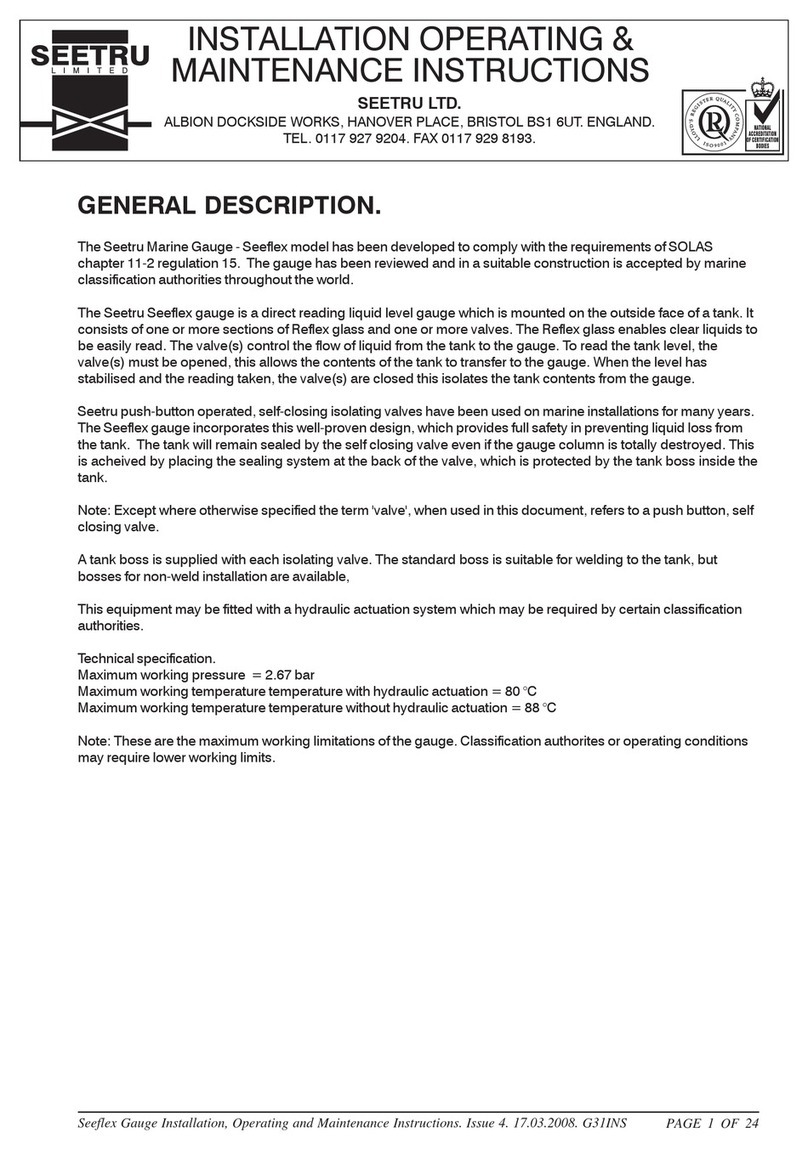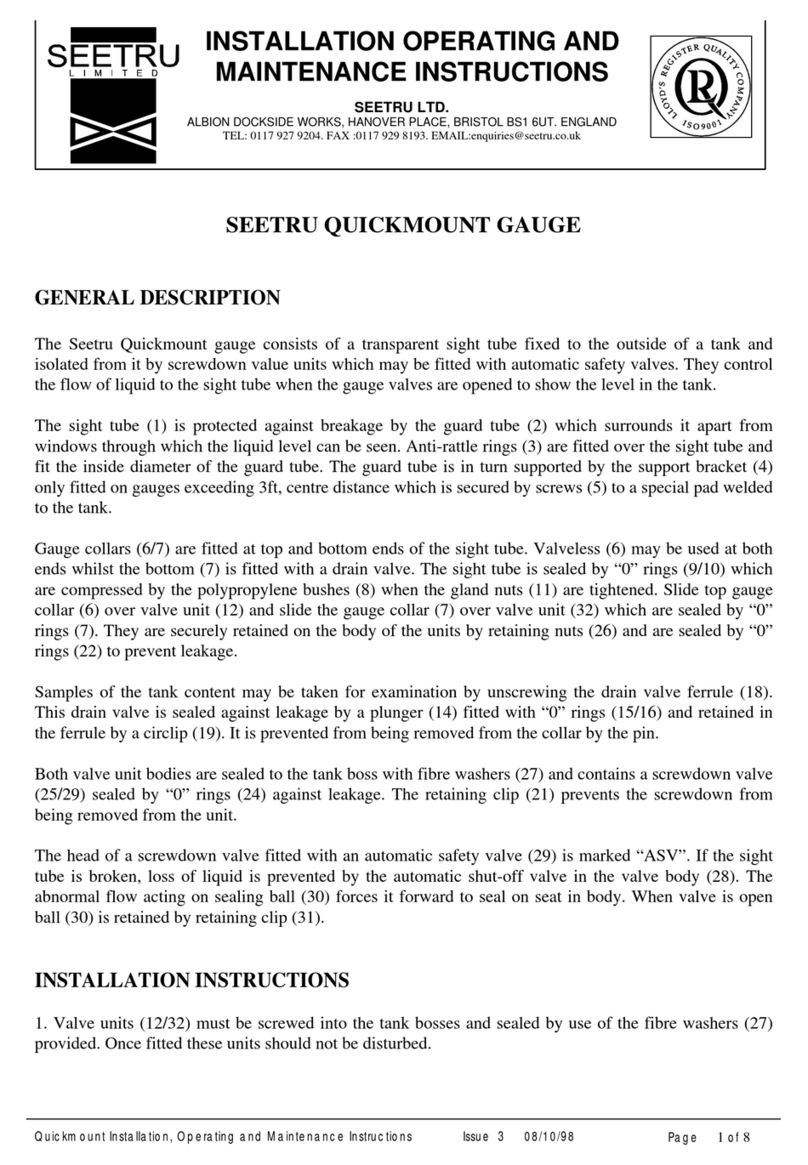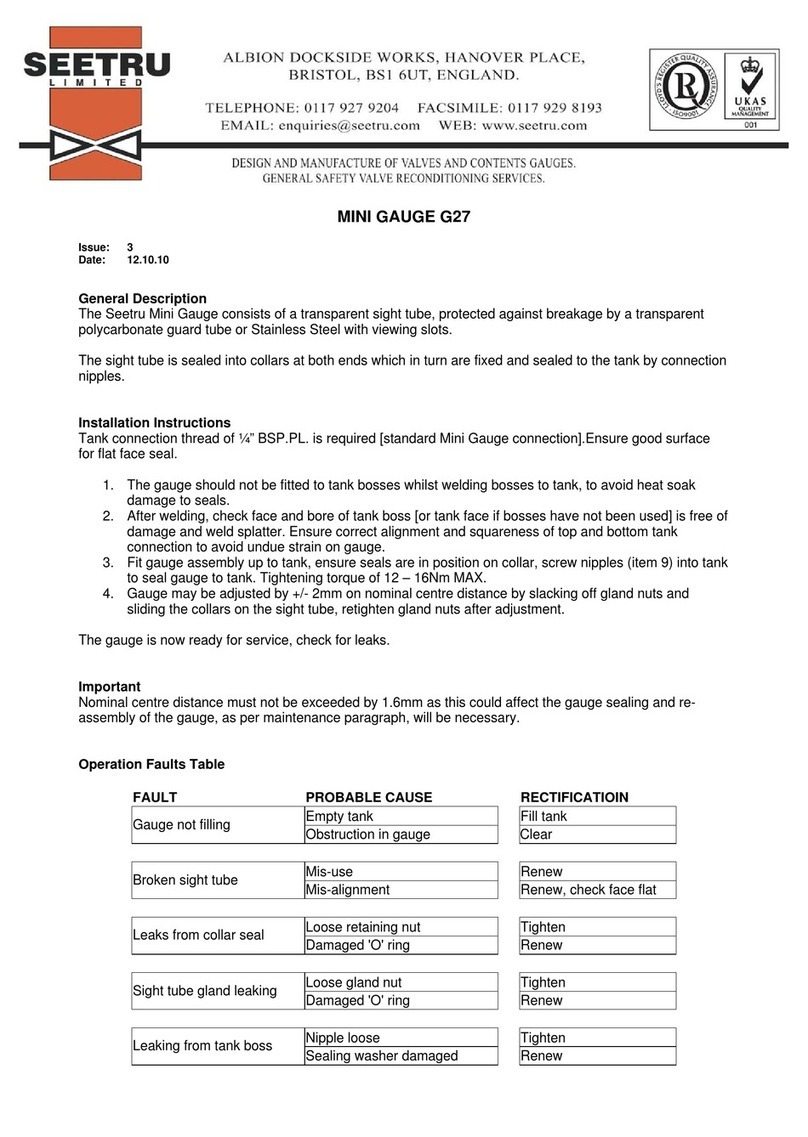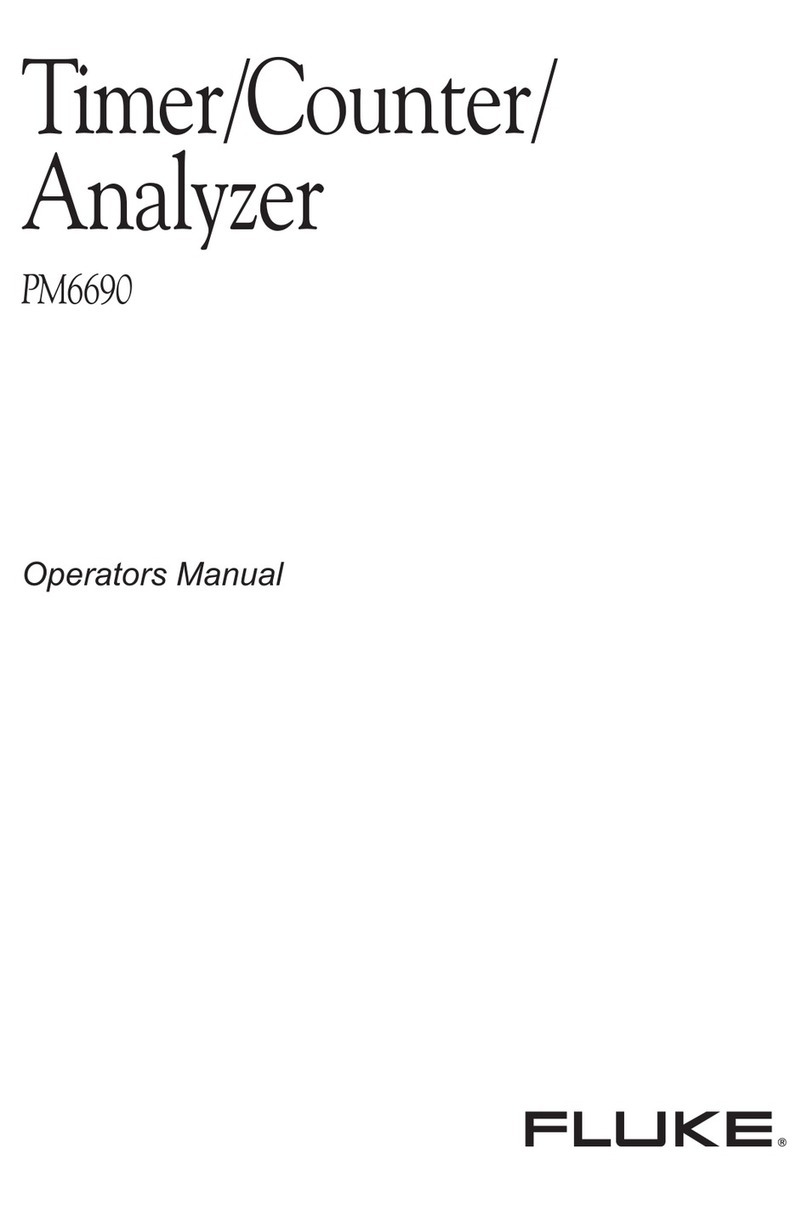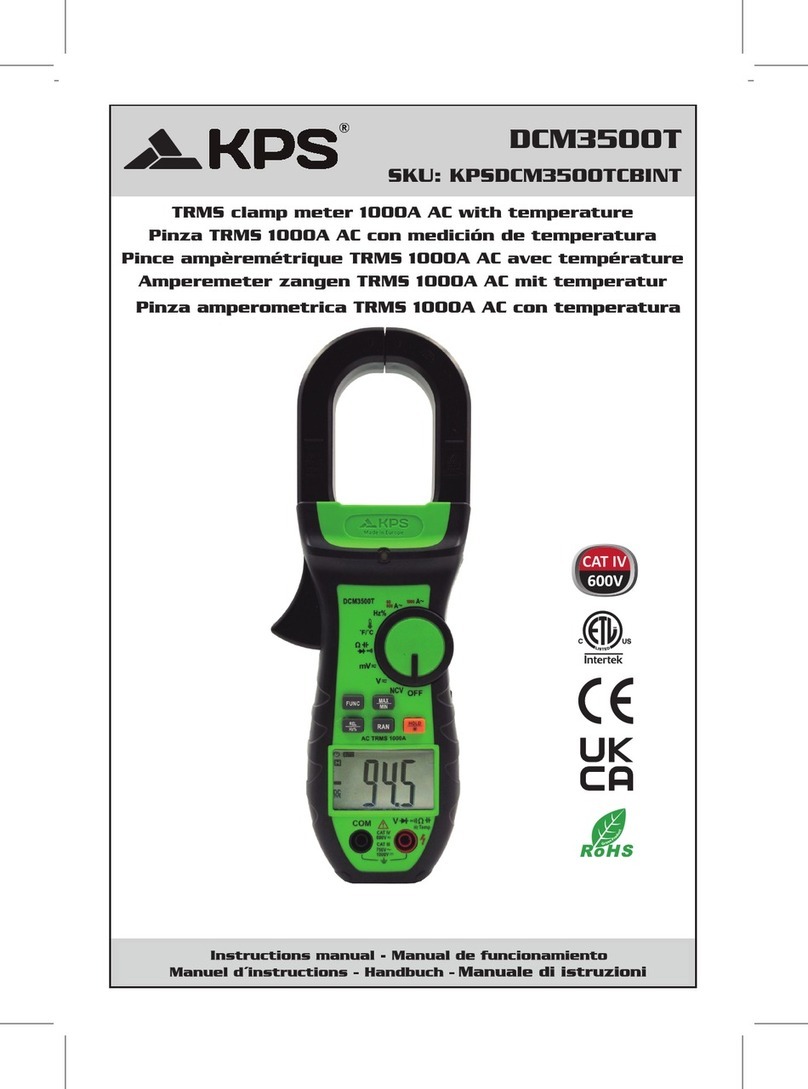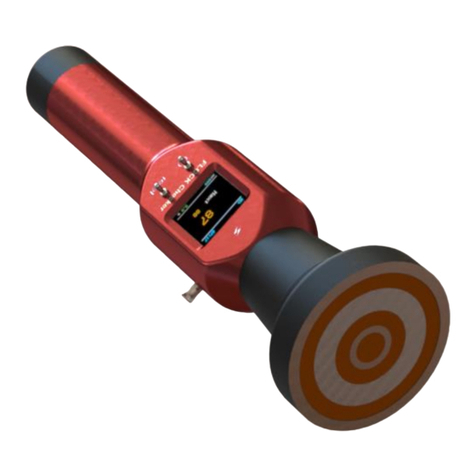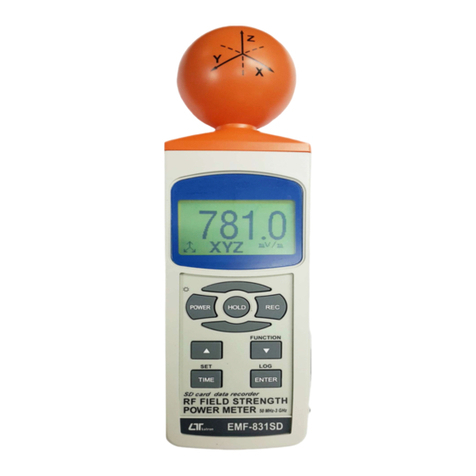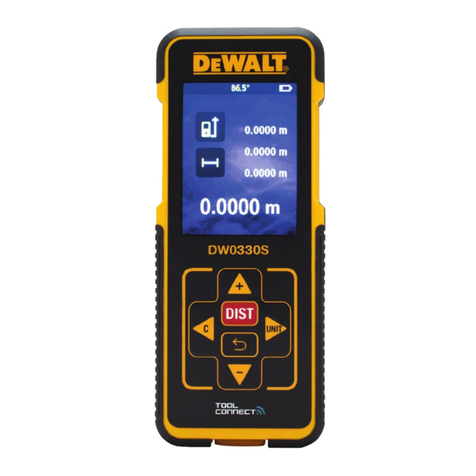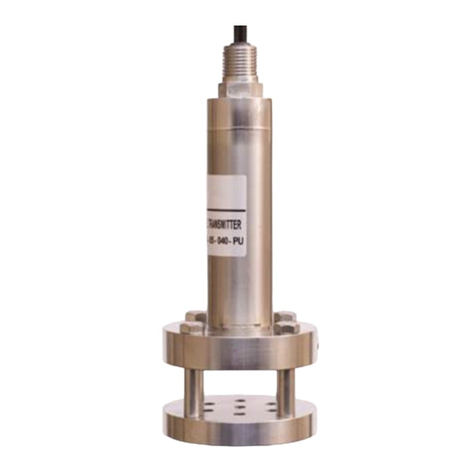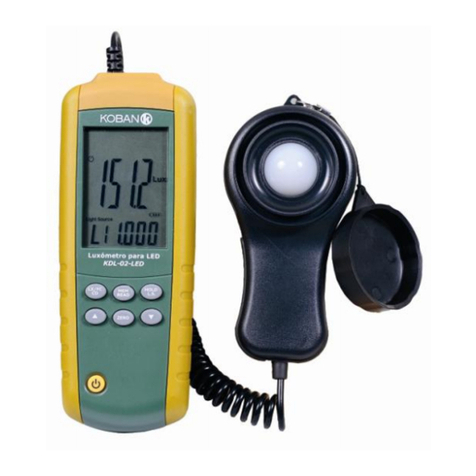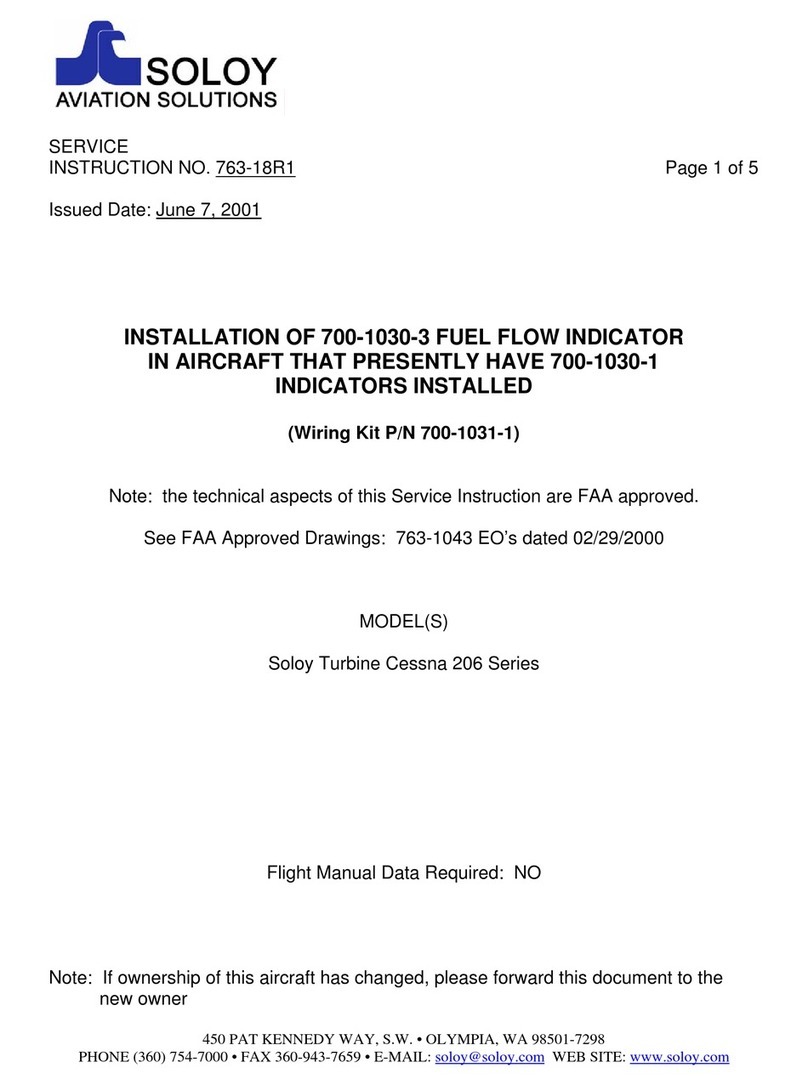Seetru G23 Assembly instructions

CPI TUBULAR GAUGE G23
INSTALLATION, OPERATING &
MAINTENANCE INSTRUCTIONS
SEETRU LIMITED
ALBION DOCKSIDE WORKS, HANOVER PLACE, BRISTOL BS1 6UT. ENGLAND
TEL. 0117 9279 204. FAX 0117 929 8193.
EMAIL: enquires@seetru.com WEB: www.seetru.com
1
GENERAL
The CPI Tubular gauge is designed and constructed to provide direct level observation of liquids,
including chemicals and solvents. The gauge column is fixed to the outside of a tank and isolated from
the tank by screw down valves which control the flow of liquid into the column and isolate the gauge
when completely closed.
Each isolating valve incorporates an automatic safety valve. Should the sightglass be broken, the
abnormal flow of liquid acting on the ball in the valve, forces it forward onto the seat in the valve body,
thereby checking the flow of liquid until the isolating valves can be closed.
Warning: The automatic safety valves are only able to operate when the isolating valves are fully open.
It is vital that the isolating valves are always left in a fully open or fully closed position. Never
leave them in a partially open position.
The isolating valves and valveless units are constructed of stainless steel 316 wetted parts, PTFE seals
and plastic handwheel. Other parts of the valves are constructed in stainless steel.
THE TUBULAR COLUMN ASSEMBLY
There are two types of Tubular Column Assemblies:
1. Tubular borosilicate glass tube protected by a stainless steel guard tube, model G231.
2. Tubular borosilicate glass tube protected by a stainless steel guard tube, as above, but further
protected by a polycarbonate tube which completely covers the stainless steel guard tube, model
G232.
All metal parts are rust proofed.
GAUGES FITTED WITH ISOLATING VALVES TOP AND BOTTOM
On these gauges the column can be removed without draining the tank. Before removal close both
isolating valves and drain the column.
GAUGES FITTED WITH ISOLATING VALVE AT BOTTOM ONLY AND A VALVELESS UNIT AT THE
TOP
On these gauges the tank contents must be below the top unit, the bottom isolating valve must be closed
and the column drained before attempting to remove the column.
Note: Valveless units should not be fitted on pressurised tanks or installed on other tank below the
highest liquid level, as they cannot be fitted with auto safety valves (ASV).
Sampling/Drain Valves or Drain/Vent Plugs should be fitted to isolating valves if tank needs to be
drained.

CPI TUBULAR GAUGE G23
INSTALLATION, OPERATING &
MAINTENANCE INSTRUCTIONS
SEETRU LIMITED
ALBION DOCKSIDE WORKS, HANOVER PLACE, BRISTOL BS1 6UT. ENGLAND
TEL. 0117 9279 204. FAX 0117 929 8193.
EMAIL: enquires@seetru.com WEB: www.seetru.com
2
APPLICATION
Use the CPI Tubular gauge only with fluids which guarantee reliable function, and to which the materials
employed that come into contact with the fluid are adequately resistant.
In addition: No heavy soiling
No coarse particles
No crystallization
INSTALLATION
Installation must be undertaken by a qualified technician and to good engineering practice. In addition,
users attention is drawn to our joint responsibility to ensure that the health and safety at work act is not
contravened by incorrect installation, commissioning or servicing.
Fitting Gauge to Tank:
1. Ensure that the tank flanges are vertically in line with each other and that the flange faces are
parallel to the tank wall. Make sure that there are no obstructions between the gauge and tank
flange faces.
2. Fit suitable gaskets between gauge and tank flange and secure flanges together using suitable
nuts, bolts and washers. Make sure column is in no way strained, then tighten bolts.
3. The gauge is supplied in a single section up to 1000mm. Longer columns are supplied, in
general, with intermediate supports, which divide the column into sections, each not exceeding
1000mm. A suitable support pad will be required on the tank, to fix the support bracket.
4. Open valves and check gauge for leaks. Rectify any leaks in accordance with maintenance
information instructions.
OPERATING INSTRUCTIONS
To Open Gauge:
1. Open top valve fully (if fitted).
2. Open bottom valve slowly until fully open (to prevent auto safety valve snapping shut). If auto
safety valve does close off flow of liquid into column, close isolating valve fully and then open
approximately half a turn to allow liquid to find its own level, then open fully.
To Close Gauge:
1. Close isolating valves fully.
To Drain Gauge:
1. Close isolating valves fully.
2. Open drain valve or unscrew drain plug. Protect hands from flow of liquid.
3. Close drain valve or replace drain plug immediately after draining.

CPI TUBULAR GAUGE G23
INSTALLATION, OPERATING &
MAINTENANCE INSTRUCTIONS
SEETRU LIMITED
ALBION DOCKSIDE WORKS, HANOVER PLACE, BRISTOL BS1 6UT. ENGLAND
TEL. 0117 9279 204. FAX 0117 929 8193.
EMAIL: enquires@seetru.com WEB: www.seetru.com
3
OPERATION FAULTS
General Faults
Fault Possible Cause Rectification
Gauge not filling Empty Tank.
Obstruction in gauge.
Obstruction in valve.
ASV closed.
Fill
Clear
Clear
See Note 1
Filling to incorrect level Incorrect use of gauge.
Incorrectly installed.
ASV closed.
See Notes 1 & 2
See Note 3
See Note 1
Broken sight tube Mis-use.
Misalignment. Renew
Check alignment of tank flange
face
Leak between flanges Valve body loose.
Flange bolts loose.
Flange gasket damaged.
Tighten
Tighten
Renew
Leak between valve body and
sight tube/drain valve adaptors Loose retaining bolts.
Damaged ‘O’ Ring. Tighten
Renew
OPERATION FAULT NOTES
Note 1 It must be appreciated that the automatic safety valve (ASV) is very sensitive to a sudden flow of
liquid through the valve unit, and that the sudden surge of liquid into an empty gauge from a full
tank is good assimilation of a broken sight glass, and therefore the ASV would close preventing
the tank contents from reaching the sightglass. In order to prevent this occurring, the lower valve
must be opened very slowly. If the ASV has sealed off the sightglass, normal operation may be
resumed by the following means:
1. Close bottom valve which, when fully closed, re-opens the ASV.
2. Open bottom valve a half turn to allow liquid to find its own level, then open fully.
Note 2It should be noted that when this gauge is fitted with valves at the top and bottom, the tank liquid
level shown may be incorrect if the bottom valve is only operated. This is due entirely to the upper
valve being closed, trapping the air in the upper part of the sight glass, so that the column of
liquid is unable to find its natural level. This is corrected by opening the upper valve.
Note 3If the CPI Tubular Gauge is installed on piping runs, the pipes should be rigid and supported so
that the longitudinal expansion of the gauge is resisted.
In addition, the piping runs should be installed so that they run down from tank to gauge and
hence be self venting, as any trapped air pockets will cause the gauge to read incorrectly.

CPI TUBULAR GAUGE G23
INSTALLATION, OPERATING &
MAINTENANCE INSTRUCTIONS
SEETRU LIMITED
ALBION DOCKSIDE WORKS, HANOVER PLACE, BRISTOL BS1 6UT. ENGLAND
TEL. 0117 9279 204. FAX 0117 929 8193.
EMAIL: enquires@seetru.com WEB: www.seetru.com
4
ISOLATING VALVE FAULTS
Note: The following table lists the most common faults found with isolating Valves. For rectification of the
faults please refer to the appropriate Maintenance Instruction listed in the Maintenance section of this
manual.
Fault Remedy Item
Number Maintenance
Instruction
Leak between main valve body and
adaptor Replace ‘O’ Ring 12 A
Leak between main valve body and
drain valve body Replace ‘O’ Ring 12 D
Drain valve leak through spout when
closed Replace ‘O’ Ring 28 H
Drain valve leak through
spindle/seal nut Replace ‘O’ Ring 24 E
Leak from valve body near
handwheel Tighten gland nut.
Replace gland and ‘O’ ring 3 & 4 G
Leak from tank to gauge when valve
is closed Replace ‘O’ Ring 21 G
Leak from adaptor and sight tube Replace ‘O’ Ring 16 A
MAINTENANCE INSTRUCTIONS
A. To Remove Gauge from Tank
1. Close isolating valves and isolate gauge if required
2. Remove flange gauge fixing bolts
3. Remove gauge from tank complete with gasket if required
4. Check and renew gasket if required
5. Refit gauge to tank complete with gasket
6. Refit flange gauge fixing bolts
7. Open isolating valves and check for leaks
B. To Replace Sight Tube or Sight Tube Seals
1. Close main valve and drain sight tube
2. Remove nuts, item 15, on both valves and remove bolts, item 14, clamps and ancillary parts
3. Slide sight tube and guard tube assembly (complete with adaptors) out from between the two
main valves.
4. Unscrew the gland nuts at each end of the sight tube, remove adaptors from each end (single
section), or adaptor/intermediate support (multi section). Slide off guard tube, ‘O’ rings, bushes,
gland nut and anti-rattle rings (if fitted).
5. Check sight tube and seals and replace if necessary.

CPI TUBULAR GAUGE G23
INSTALLATION, OPERATING &
MAINTENANCE INSTRUCTIONS
SEETRU LIMITED
ALBION DOCKSIDE WORKS, HANOVER PLACE, BRISTOL BS1 6UT. ENGLAND
TEL. 0117 9279 204. FAX 0117 929 8193.
EMAIL: enquires@seetru.com WEB: www.seetru.com
5
6. Slide guard tube and ant-rattle rings over sight tube, and refit gland nuts, bushes and ‘O’ rings
onto the sight tube. Screw gland nuts into adaptors/intermediate support bracket.
7. Refit sight and gauge tube assembly between valves.
8. Refit clamp plates, ancillary equipment and bolts at each end and tighten bolts – ensure ‘O’ rings
are in grooves in ancilliary parts (screw intermediate support bracket back to tank if fitted).
9. Close drain valve if fitted
10. Open top valve fully
11. Open lower valve slowly to prevent ASV closing
12. If ASV operates, close lower valve and then re-open slowly again – test for leaks, if any rectify
13. Close valves
14.
C. To replace spindle ‘O’ rings on drain valve assembly
This operation can be carried out with drain valve in situ, or removed from main valve. In either
case the main valve must be closed and the sightglass drained.
1. Loosen grub screw in side of drain body. Withdraw from body complete with plunger
2. Remove seal nut at base of drain valve body
3. Replace ‘O’ rings on plunger and seal nut
4. Refit seal nut and plunger in body. Unscrew plunger to ensure seal nut seats in counter bore
5. Tighten grub screw
6. Screw Plunger into seal
7. Open main valve and check for leaks – rectify if any
8. Close main valve
D. To remove Flange Gasket
WARNING: The tank must be drained to a level below the valve before carrying out work to replace
the flange gasket.
1. Remove flange bolts
2. Replace flange gasket
3. Replace flange bolts and tighten bolts
E. To replace Gasket and/or Gland Assembly
WARNING: The tank must be drained to a level below the valve before carrying out work to replace
the flange gasket.
Note: To replace gasket/spindle assembly the spindle must be removed from the body. (The body
can be left in situ.)
1. Turn valve handwheel anticlockwise as far as it will go. The gland nut (6) will then be visible with
easy access to the end of the body.
2. Remove set screw (8) and locking nut (9)
3. Withdraw spindle assembly from body
4. Separate handwheel from spindle
5. Remove gland nut (6) and spindle nut (5)

CPI TUBULAR GAUGE G23
INSTALLATION, OPERATING &
MAINTENANCE INSTRUCTIONS
SEETRU LIMITED
ALBION DOCKSIDE WORKS, HANOVER PLACE, BRISTOL BS1 6UT. ENGLAND
TEL. 0117 9279 204. FAX 0117 929 8193.
EMAIL: enquires@seetru.com WEB: www.seetru.com
6
6. Replace gland and spindle nut
7. Replace gland and ‘O’ rings as necessary
8. Refit set screw and locking nut (ensure set screw locates in slot in spindle nut to prevent
turning). Take care not to clamp – it should be free to slide but not turn
9. Tighten gland nut
10. Fill tank
11. Open valve, check for leaks, rectify if any
12. Close valve
F. To inspect or renew ASV ball
1. Drain tank below level of valve being inspected
2. Drain gauge column and column remove from isolating valves
3. Remove unit(s) from tank flange
4. Remove retaining clip
5. Inspect or renew ball and clip
6. Check internal passages are clear
7. Refit ball and clip
8. Check that tank flange face is smooth and clean. Refit valve unit to flange with gasket in position.
9. Refit gauge column
10. Refill tank
11. Open valves as previously described. Check for leaks and rectify if any
12. Close valves

CPI TUBULAR GAUGE G23
INSTALLATION, OPERATING &
MAINTENANCE INSTRUCTIONS
SEETRU LIMITED
ALBION DOCKSIDE WORKS, HANOVER PLACE, BRISTOL BS1 6UT. ENGLAND
TEL. 0117 9279 204. FAX 0117 929 8193.
EMAIL: enquires@seetru.com WEB: www.seetru.com
7
General Assembly – Figure 1
Item Number Number Off
per Unit Description
1 1 Valve Body
2 1 Spindle
3 1 ‘O’ Ring
4 1 Gland
5 1 Spindle Nut
6 1 Gland Nut
7 1 Handwheel
8 1 Set Screw
9 1 Locknut
10 1 Ball
11 1 Retaining Clip
12 2 ‘O’ Ring
13 2 Clamp
14 2 Bolt
15 2 Nut
16 1 Inner Guard Tube
17 1 Tube Nut
18 1 Sight Tube
19 1 ‘O’ Ring
20 1 Blanking Plate
21 1 ‘O’ Ring
22 1 Knob Clip
23 1 Drain Valve Body
24 1 ‘O’ Ring
25 1 Sealing Nut
26 1 Set Screw
27 1 Retaining Clip
28 1 ‘O’ Ring
29 1 Plunger
30 1 Drain Tube
31 1 Body – Drain Plug
32 1 Plug
33 1 ‘O’ Ring
34 1 Drive Screw
35 1 Chain
36 1 Gland Bush
37 1 Gland Nut
38 1 ‘O’ Ring
39 1 Outer Guard Tube

CPI TUBULAR GAUGE G23
INSTALLATION, OPERATING &
MAINTENANCE INSTRUCTIONS
SEETRU LIMITED
ALBION DOCKSIDE WORKS, HANOVER PLACE, BRISTOL BS1 6UT. ENGLAND
TEL. 0117 9279 204. FAX 0117 929 8193.
EMAIL: enquires@seetru.com WEB: www.seetru.com
8
Figure 1
Table of contents
Other Seetru Measuring Instrument manuals
Popular Measuring Instrument manuals by other brands
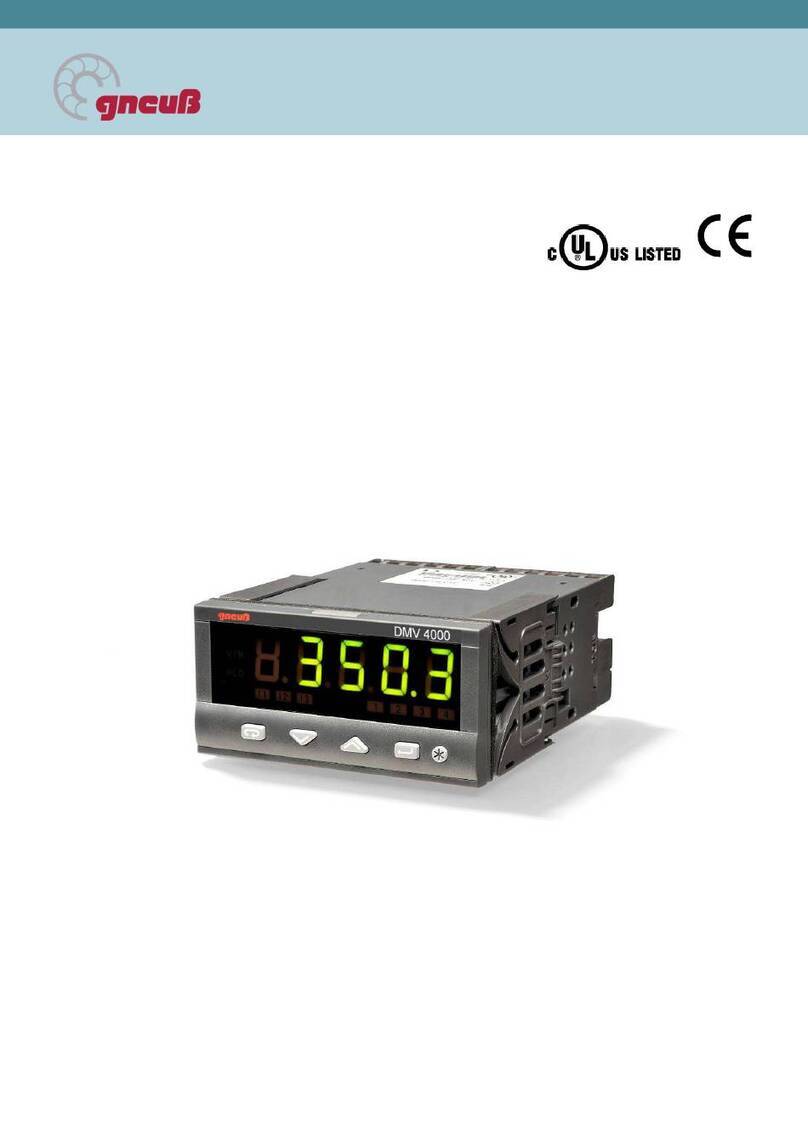
gneuss
gneuss DMV 4000 operating instructions
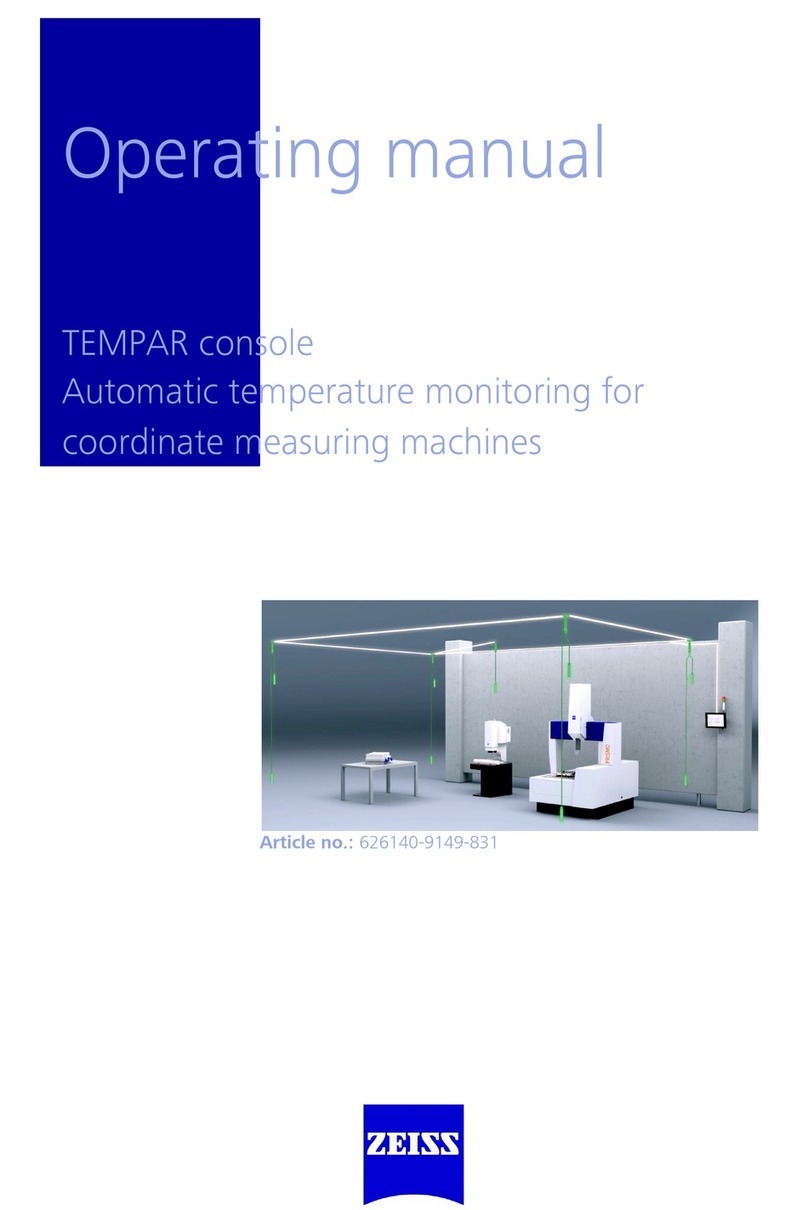
Zeiss
Zeiss TEMPAR console operating manual
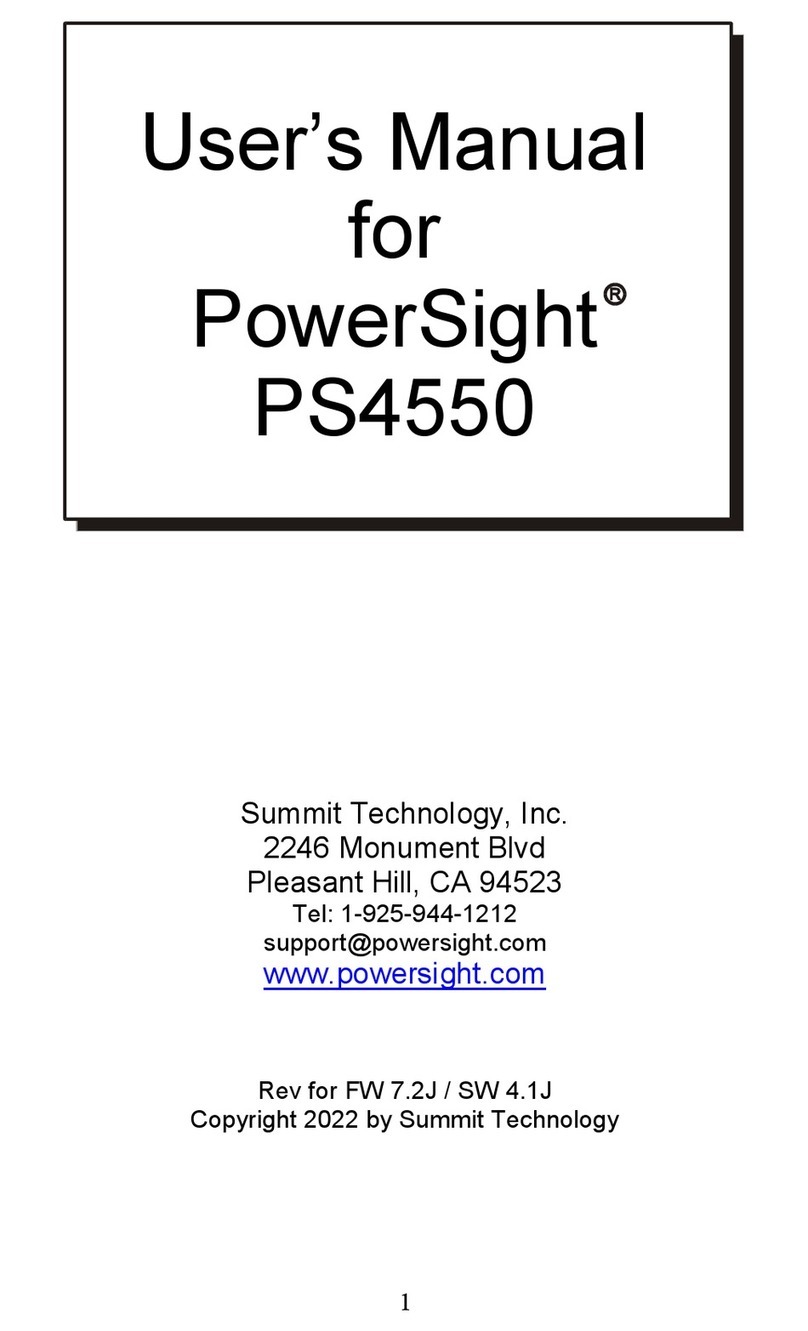
Summit Technology
Summit Technology PowerSight PS4550 user manual
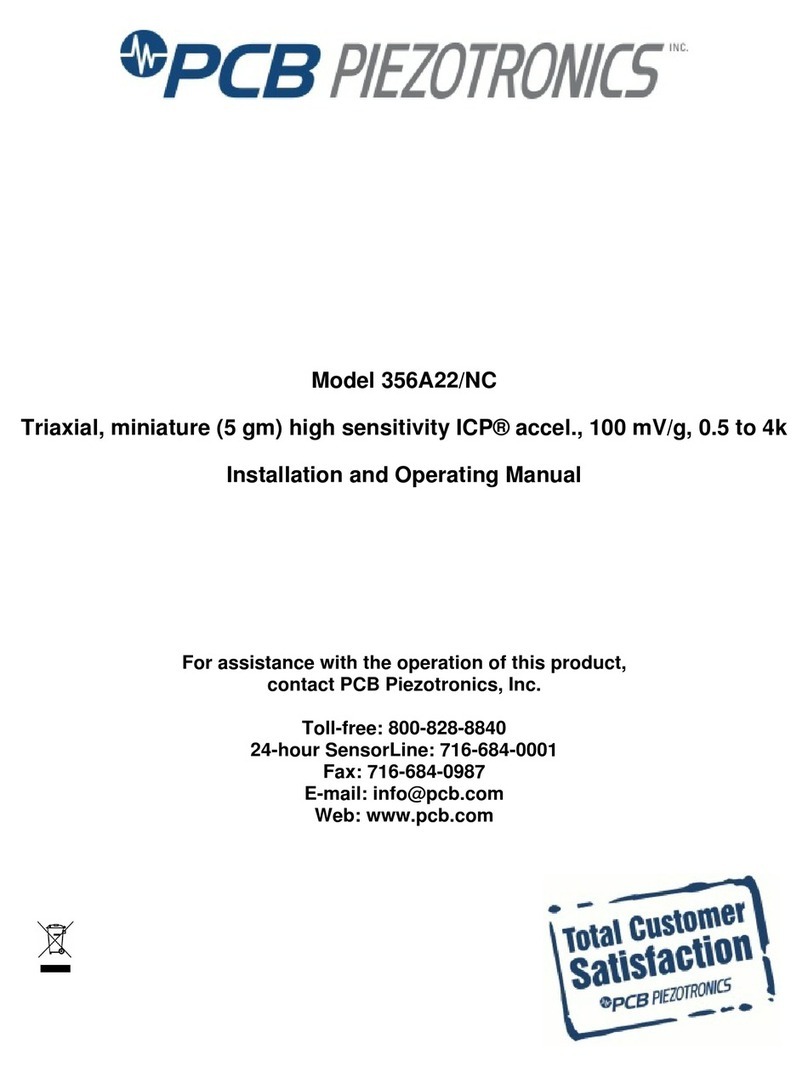
PCB Piezotronics
PCB Piezotronics 356A22/NC Installation and operating manual
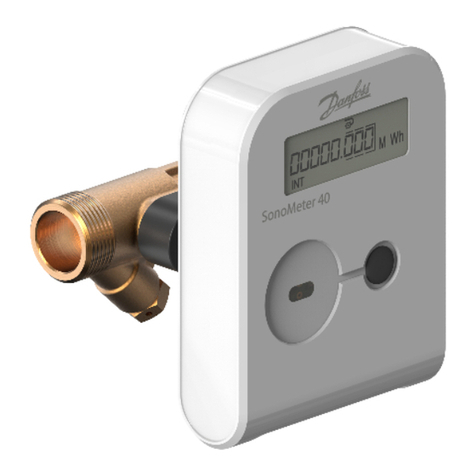
Danfoss
Danfoss 40 Calibration Instruction
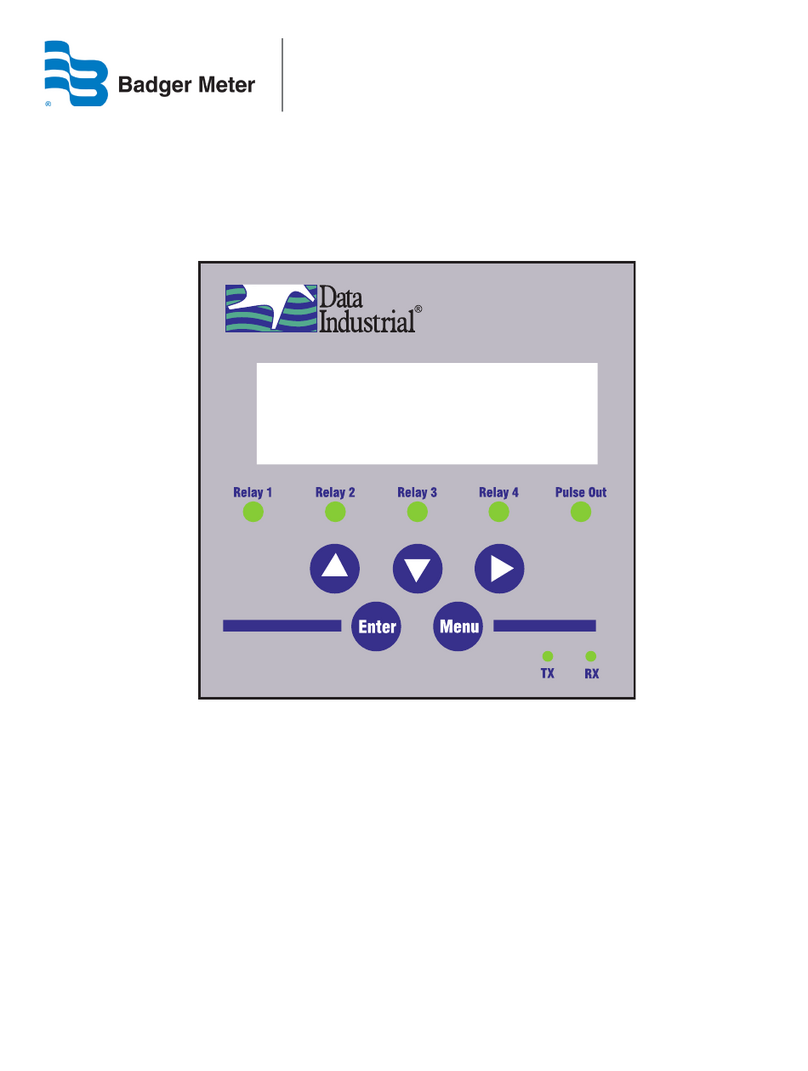
Badger Meter
Badger Meter Impeller Data Industrial 3050 Series Installation & operation manual
